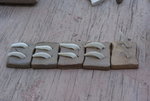LittleDingus
Omono
I imagine, as with most things, this is a huge topic! I'll never be a potter but I would like to understand some of the basics if only to know how to better shop 
Some questions:
What's a cone? And how many do I need?
I understand that a cone is something to do with how hot a piece is fired, but what does the term mean? And how hot does it need to be fired to have a reasonable chance of surviving the outside in, say zone 5?
I do have a pot or 3. On one of them, the glaze is cracked. I think that is intentional? I've seen some advertized as "cracked glaze"...is there a danger of the glaze cracking and flaking off?
Is there a structural difference between wheel thrown and slab constructed? When building with slabs, is there a danger of the joints popping because it's hard to whet the clay together that way? I'm thinking my childhood days when it was frustrating to get two pieces of clay to stick together...always trying to smooth over the seam but is always seemed to break. But maybe the oil clays I played with as a child don't behave the same as the clays used to make pots?
Anyway, I'm not looking for a dissertation on pottery (but if you're willing to write one, I'll happily read it!) I know it's a big subject. I would like to at least understand some of how the process works so I can better judge if what I'm looking at are worth the vastly different prices potters charge or not. I'm not above paying for quality and I certainly understand paying for an artists time...but there are some many potters at so many price points that I feel I'm too uneducated to judge value
Thanks in advance for any information!
Some questions:
What's a cone? And how many do I need?
I understand that a cone is something to do with how hot a piece is fired, but what does the term mean? And how hot does it need to be fired to have a reasonable chance of surviving the outside in, say zone 5?
I do have a pot or 3. On one of them, the glaze is cracked. I think that is intentional? I've seen some advertized as "cracked glaze"...is there a danger of the glaze cracking and flaking off?
Is there a structural difference between wheel thrown and slab constructed? When building with slabs, is there a danger of the joints popping because it's hard to whet the clay together that way? I'm thinking my childhood days when it was frustrating to get two pieces of clay to stick together...always trying to smooth over the seam but is always seemed to break. But maybe the oil clays I played with as a child don't behave the same as the clays used to make pots?
Anyway, I'm not looking for a dissertation on pottery (but if you're willing to write one, I'll happily read it!) I know it's a big subject. I would like to at least understand some of how the process works so I can better judge if what I'm looking at are worth the vastly different prices potters charge or not. I'm not above paying for quality and I certainly understand paying for an artists time...but there are some many potters at so many price points that I feel I'm too uneducated to judge value
Thanks in advance for any information!


